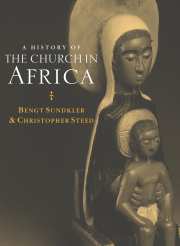Book contents
- Frontmatter
- Contents
- List of maps
- Acknowledgements
- List of abbreviations
- Introduction
- PART I THE FIRST FOURTEEN HUNDRED YEARS
- PART II THE MIDDLE AGES 1415 – 1787
- PART III THE LONG NINETEENTH CENTURY 1787 – 1919
- 3 Overview To The Nineteenth Century
- 4 North and North-Eastern Africa
- 5 Western Africa
- 6 West-Central Africa
- 7 Southern Africa
- 8 South-Central Africa and the Indian Ocean
- 9 East Africa
- 10 East-Central Africa
- PART IV THE COLONIAL EXPERIENCE 1920 – 1959
- PART V INDEPENDENT AFRICA 1960 – 92
- Notes
- Bibliography
- Name index
- Subject index
6 - West-Central Africa
from PART III - THE LONG NINETEENTH CENTURY 1787 – 1919
Published online by Cambridge University Press: 16 September 2009
- Frontmatter
- Contents
- List of maps
- Acknowledgements
- List of abbreviations
- Introduction
- PART I THE FIRST FOURTEEN HUNDRED YEARS
- PART II THE MIDDLE AGES 1415 – 1787
- PART III THE LONG NINETEENTH CENTURY 1787 – 1919
- 3 Overview To The Nineteenth Century
- 4 North and North-Eastern Africa
- 5 Western Africa
- 6 West-Central Africa
- 7 Southern Africa
- 8 South-Central Africa and the Indian Ocean
- 9 East Africa
- 10 East-Central Africa
- PART IV THE COLONIAL EXPERIENCE 1920 – 1959
- PART V INDEPENDENT AFRICA 1960 – 92
- Notes
- Bibliography
- Name index
- Subject index
Summary
INTRODUCTION
The pre-colonial setting
Adzindzali, people of the river, was the name for the ethnic communities along the Congo waterway. They considered this a name of honour – they were fishermen and proud of it. In their dugout canoes they would move over vast waters along the main river and up and down the many Congo tributaries bringing their catch to the markets, to Likuba or Ntsei or Mushei, centres used over many generations for the exchange of commodities. For ‘the environment of these people which made them fishermen also made them traders’. The Bobangi brought their smoked fish, slaves, pottery and iron implements to a Tio market. They formed their relationship with the Tio to the extent of establishing blood-brotherhood between their chiefs or ‘great men’, thus widening the horizons of each of these two communities. ‘Sharing the waters with non-Tio made them [the Bobangi] more sophisticated and gave them a much broader outlook than that of most of the landlocked agriculturalists.’
Sometimes the Bobangi canoes would take them much further down the river to Kinshasa (soon to be referred to as ‘Stanley Pool’), or up the river towards the Falls. Together with other Congo communities they came to be regarded as ‘middlemen’. For generations they were confronted with the ideas and ambitions of foreigners: to the west, Portuguese, Dutch, French; to the east the Arabs. Portuguese was the trade language of the western coast.
- Type
- Chapter
- Information
- A History of the Church in Africa , pp. 278 - 322Publisher: Cambridge University PressPrint publication year: 2000



